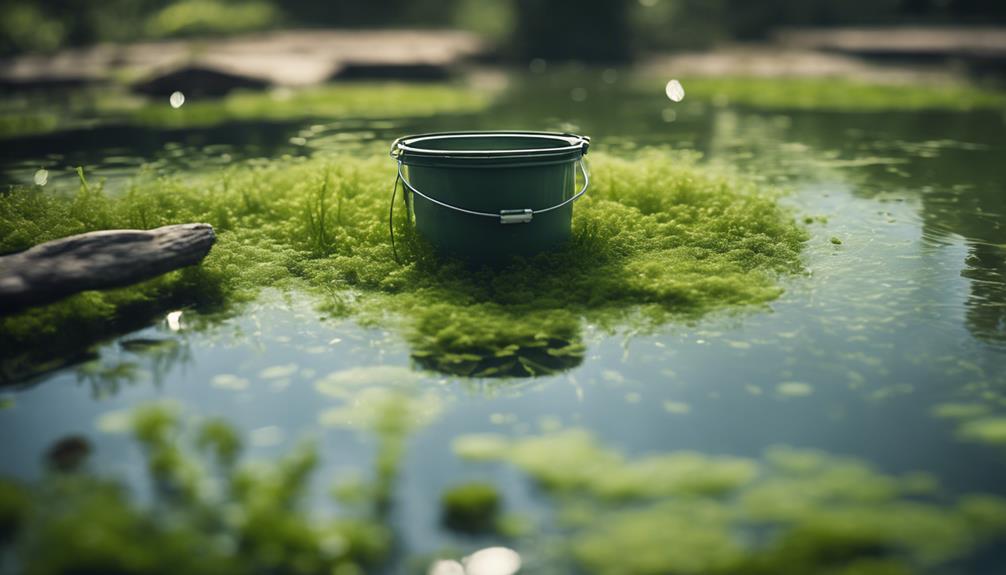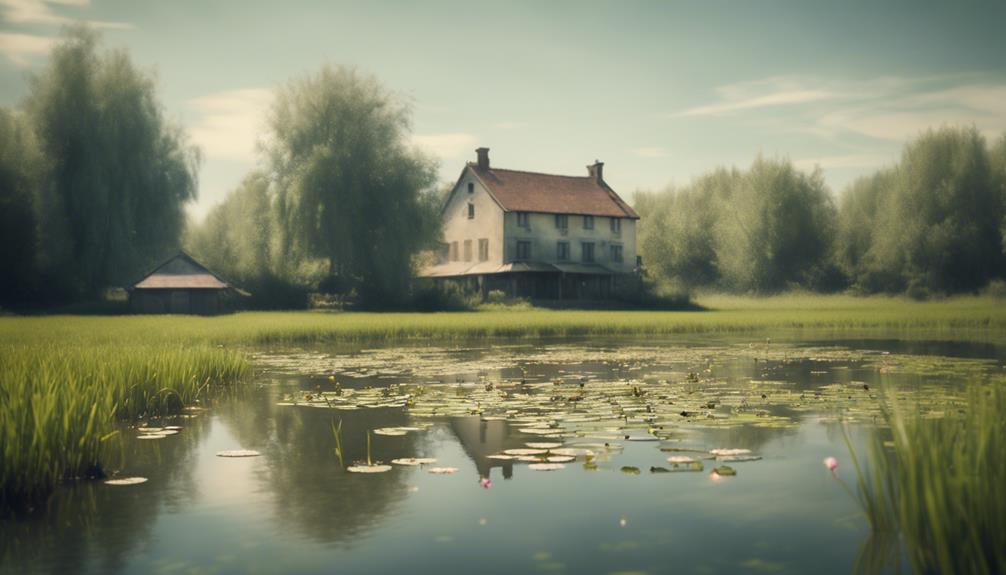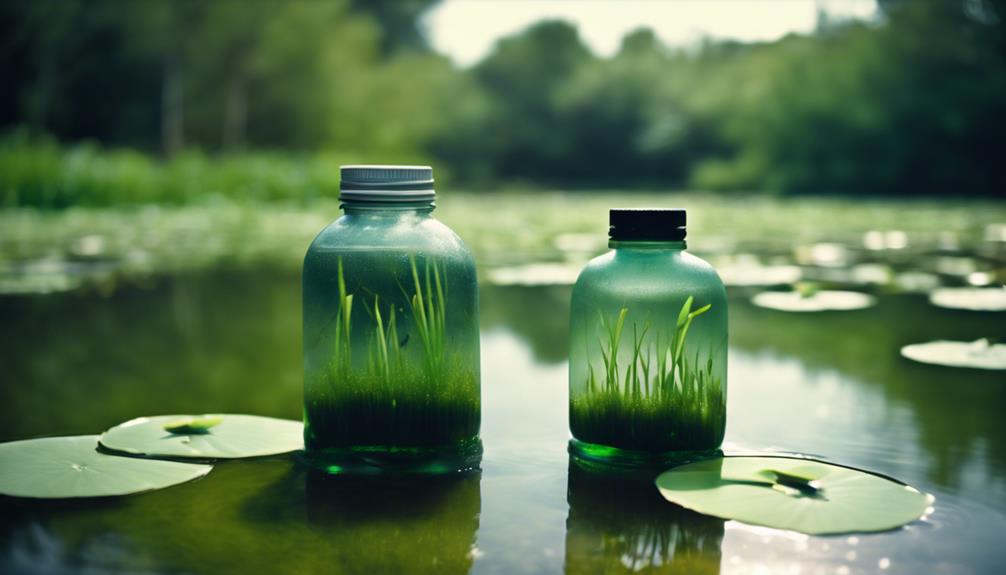You're struggling to control algae growth in your pond, and rightly so, as it can quickly overrun the ecosystem if left unchecked. Algae thrive on excess nutrients, direct sunlight, and imbalanced water chemistry. To combat this, introduce plants like water lilies, hornwort, and duckweed that outcompete algae for resources. Barley straw releases compounds that inhibit algae growth, while beneficial bacteria break down organic matter and consume excess nutrients. Implementing these natural remedies can be an effective and environmentally friendly approach. By understanding the causes of algae growth and exploring these natural solutions, you're one step closer to achieving a balanced and thriving pond ecosystem.
Table of Contents
Key Takeaways
- Introduce plants like water lilies, hornwort, and duckweed to outcompete algae for resources and absorb excess nutrients.
- Add barley straw to the pond, which releases compounds that inhibit algae growth and provide long-lasting control.
- Implement beneficial bacteria to break down organic matter, consume excess nutrients, and balance water quality.
- Maintain ideal water parameters, including proper pH levels and circulation, to prevent algae growth and promote a healthy ecosystem.
- Use natural products containing live bacteria cultures to introduce beneficial bacteria and reduce the need for algaecides and chemicals.
Understanding Green Algae
Characterized by its vibrant green color and ability to rapidly multiply, green algae is a type of phytoplankton that can quickly overtake your pond's ecosystem if left unchecked.
When you notice your pond's water turning green, it's a clear indication that algae growth is in full swing.
Preventing algae from taking over your pond requires understanding its needs. Algae need nutrients like nitrogen and phosphorus to thrive, which are often present in pond water due to runoff or decaying organic matter.
To combat algae growth, you can introduce oxygenating plants like hornwort or anacharis, which absorb excess nutrients and reduce algae's ability to multiply.
By maintaining a balanced ecosystem, you can prevent green water from becoming a persistent problem. Remember, a healthy pond ecosystem is key to controlling algae growth.
Natural Remedies and Control
As you explore natural remedies to control pond algae growth, you'll find that using natural methods can be an effective and environmentally friendly approach.
You'll want to focus on prevention strategies that address the underlying causes of algae growth, such as excess nutrients and poor water circulation.
Natural Algae Control
When it comes to controlling pond algae growth, you can explore natural remedies that harness the power of plants, microorganisms, and aeration methods to create a balanced ecosystem.
By introducing plants like water lilies, hornwort, and duckweed, you can outcompete algae for resources, naturally controlling its growth.
Another approach is to use barley straw, which releases compounds that inhibit algae growth, providing a gradual and long-lasting control method.
Beneficial bacteria can also be used to break down organic matter and consume excess nutrients, balancing and improving water quality. You can introduce these bacteria through commercial cultures or natural methods like aerating the pond.
Manual removal of algae using specialized rakes or nets provides a quick solution to reduce algae mass, and can be combined with beneficial bacteria to enhance its effectiveness.
Algae Prevention Methods
By taking preventative measures, you can reduce the likelihood of pond algae growth and create a thriving environment for your aquatic life.
Use rainwater or partial water changes to decrease the concentration of nutrients in the pond water, making it less conducive to algae growth.
Add plants like water lilies, hornwort, and duckweed, which consume the same nutrients as algae, outcompeting them for resources.
Introduce beneficial bacteria that break down organic matter, reducing the availability of nutrients for algae growth and promoting a balanced ecosystem.
Utilize barley straw, which releases compounds that inhibit algae growth, providing a gradual and long-lasting control method.
Pond Maintenance and Equipment

As you set out to control pond algae growth, you'll need to guarantee your pond's infrastructure is up to the task.
You'll want to ponder the right pond liner options to prevent leaks and damage, select a suitable pump to maintain ideal water circulation, and understand how filter systems work to remove excess nutrients.
Pond Liner Options
You can choose from a range of pond liner options, including rubber pond liners, which have proven to be a reliable and durable solution for pond containment.
As a pond owner, selecting the right liner is vital for maintaining a healthy and balanced ecosystem. Rubber pond liners, in particular, offer several benefits that make them an attractive choice.
They are flexible and durable, making them a reliable choice for pond liners. They come in various sizes and can be customized to fit any pond shape, providing a secure and watertight seal.
They are resistant to punctures and tears, and are also UV-resistant, allowing them to withstand extreme weather conditions.
They are easy to install and require minimal maintenance, making them a convenient option for pond owners.
Pump Selection Guide
With a reliable pond liner in place, your focus can now shift to selecting the right pump to maintain ideal water circulation, oxygenation, and filtration in your pond.
When choosing a pump, consider the size and shape of your pond, as well as its water volume. Submersible pumps are suitable for small to medium-sized ponds, while external pumps are better for larger ponds with complex plumbing systems.
Look for pumps with adjustable flow rates and directional outlets to customize water circulation and aeration in your pond. This will allow you to direct water flow to specific areas, promoting healthy water circulation and oxygenation.
Crucial to choose a pump specifically designed for pond use, as they're built to handle the unique demands of aquatic environments and can withstand corrosion and wear. Consider energy-efficient options like Swell UK pond pumps, which provide quiet operation and reliable performance.
Filter Systems Explained
Effective filter systems are essential to maintaining water quality in your pond, as they remove waste and debris, and convert harmful toxins into harmless compounds. A well-designed filter system guarantees that your pond water is clean, clear, and healthy for your aquatic life.
When it comes to filter systems, you'll want to ponder both mechanical and biological filtration methods.
Mechanical filtration removes physical waste and debris from the water using filters, nets, or other devices.
Biological filtration uses aerobic bacteria to break down ammonia and nitrite into harmless compounds.
Water circulation is pivotal for maintaining oxygen levels and preventing stagnation, which can lead to algae growth.
Filter maintenance is imperative, requiring regular cleaning and maintenance to guarantee your filter system operates efficiently and effectively.
Fish and Aquatic Life Overview
As you introduce fish and other aquatic life to your pond, it's essential to ponder their specific requirements to guarantee a thriving ecosystem.
Fish and aquatic life play a pivotal role in maintaining a balanced pond environment, and their needs must be considered when creating a harmonious coexistence with algae in ponds.
For instance, certain species like axolotls require a specific water temperature range of 15-18°C (59-64°F) and a pH level of 7.4-7.6.
Providing the right food is also indispensable, as it directly impacts their health and growth.
Swell UK offers a variety of pond fish food options, formulated to meet the nutritional needs of different fish species.
By choosing high-quality food, you can promote healthy digestion and growth in your fish.
Remember, a thriving aquatic life can help regulate plants and algae, preventing algae overgrowth and maintaining a balanced ecosystem.
Causes of Algae Overgrowth

You've likely noticed that even with a thriving aquatic life, your pond's ecosystem can still be disrupted by an overabundance of algae, which is often triggered by an imbalance of nutrients, light, and other environmental factors.
The truth is, algae overgrowth is often caused by a combination of factors that fuel algae blooms.
Excess organic matter, such as decaying plant material or fish waste, provides a rich source of nutrients for algae to thrive.
Direct sunlight stimulates algae growth by providing the necessary energy for photosynthesis.
Imbalanced water chemistry, such as excessive levels of phosphorus or nitrogen, can trigger rapid algae growth.
Insufficient water circulation allows algae to settle and multiply unchecked.
Natural Remedies for Pond Algae
Implementing natural remedies for pond algae control can be a cost-effective and environmentally friendly approach to maintaining a balanced ecosystem. You can naturally control algae growth by introducing plants that consume algae, reducing the need for chemical treatments. Submerged plants like Hornwort and Cabomba absorb excess nutrients, preventing algae growth. Marginal plants like Water Lilies and Cattails provide shade, reducing algae's ability to photosynthesize.
| Plant Type | Algae Control Method | Benefits |
|---|---|---|
| Submerged Plants | Absorb excess nutrients | Reduces algae growth, oxygenates water |
| Marginal Plants | Provides shade, reduces photosynthesis | Enhances aesthetics, creates habitat for wildlife |
| Floating Plants | Shades water surface, reduces algae growth | Rapidly multiplies, easy to maintain |
Manual Removal and Beneficial Bacteria

In addition to natural remedies, manually removing excess algae and introducing beneficial bacteria can provide a multi-faceted approach to controlling pond algae growth.
You can physically remove algae by skimming the surface of the pond with a net or by using a pond vacuum to remove algae from the bottom. This manual removal process helps reduce the amount of organic matter that can contribute to algae growth.
In addition to manual removal, introducing beneficial bacteria can help break down organic matter and reduce algae growth. These beneficial bacteria can be added to your pond using natural products that contain live bacteria cultures.
- Break down organic matter, reducing the fuel for algae growth
- Improve water clarity and quality
- Reduce the need for algaecides and other chemicals
- Create a balanced ecosystem that supports aquatic life
Preventing Algae Growth Naturally
Preventing Algae Growth Naturally
By maintaining ideal water parameters and creating an environment that favors the growth of beneficial aquatic plants, you can naturally prevent algae growth in your pond. This approach not only reduces unwanted algae but also promotes a healthy ecosystem. One key aspect is to guarantee proper water circulation, which helps to prevent stagnation and reduces the likelihood of algae growth.
| Method | Description | Benefits |
|---|---|---|
| Introduce Beneficial Plants | Add plants like water lilies or cattails to absorb excess nutrients | Reduces algae growth, improves water quality |
| Maintain Proper pH Levels | Monitor and adjust pH levels to ideal range (6.5-8.5) | Prevents algae growth, promotes healthy aquatic life |
| Limit Nutrient Input | Reduce fertilizer use, prevent runoff, and maintain a balanced ecosystem | Reduces algae growth, maintains water clarity |
Frequently Asked Questions
How to Reduce Algae in a Pond Naturally?
To reduce algae in your pond naturally, you'll want to establish a balanced ecosystem. Try introducing Pond Aeration methods, like waterfalls or fountains, to improve Water Clarity and promote Algae Prevention by supporting beneficial bacteria, ultimately achieving a Natural Balance with Eco-Friendly Methods.
What Natural Remedy Kills Algae?
You can utilize organic treatments like beneficial bacteria, natural sanitizers, and pond clarifiers to create an aquatic balance that prevents algae growth, effectively killing existing algae while maintaining a healthy ecosystem.
Does Vinegar Kill Algae in Ponds?
"Wow, you're still wondering if vinegar kills algae in ponds? Yes, it does! Vinegar's acetic acid inhibits photosynthesis, making it effective against green water algae, but its effectiveness varies with pH levels and dosage, requiring repeated applications to combat algae resistance."
How to Remove Algae From Water Plants Naturally?
When removing algae from water plants naturally, you'll want to try algae scrubbers, enhancing plant filtration, and promoting water aeration to maintain aquatic balancing, ensuring oxygen infusion and a healthy ecosystem for your plants to thrive.
Conclusion
Controlling pond algae growth is a delicate balance of natural remedies, maintenance, and understanding the underlying causes.
Now, it's time to take the reins and reclaim your pond's serenity.
Like a master gardener pruning a blooming garden, you can cultivate a thriving ecosystem by wielding the power of nature against algae's invasive grasp.
By embracing these DIY solutions, you'll be well on your way to a crystal-clear pond that's teeming with life.

